Showing all posts tagged "Construction"
Rubber Roofs - Low Maintenance - Sky Roofing Construction & Remodeling

Posted on June 21st, 2024
Rubber Roofs - Sky Roofing Construction & Remodeling - Call (210) 942-9797

Posted on June 21st, 2024
Rubber Roofs - Types of Rubber Roofs - Sky Roofing Construction & Remodeling

Posted on June 21st, 2024
Rubber Roofs - Benefits of Rubber Roofs - Sky Roofing Construction & Remodeling

Posted on June 21st, 2024
Benefits of Rubber Roofs: Durability, Energy Efficiency, and Sustainability

Rubber Roofs
Overview of Rubber Roofing Membranes
In commercial roof systems, choosing a suitable flat roofing material is crucial. A flat roofing project must consider cost, durability, and maintenance. Due to their specific benefits, EPDM, TPO, and PVC are popular choices for commercial roof systems. While EPDM is a shared roof material for its cost-effectiveness and ease of installation, TPO offers additional energy efficiency, making it suitable for environmentally conscious projects. PVC, though the most expensive, provides the most extended lifespan and the highest resistance to environmental factors, making it ideal for long-term flat roofing projects.
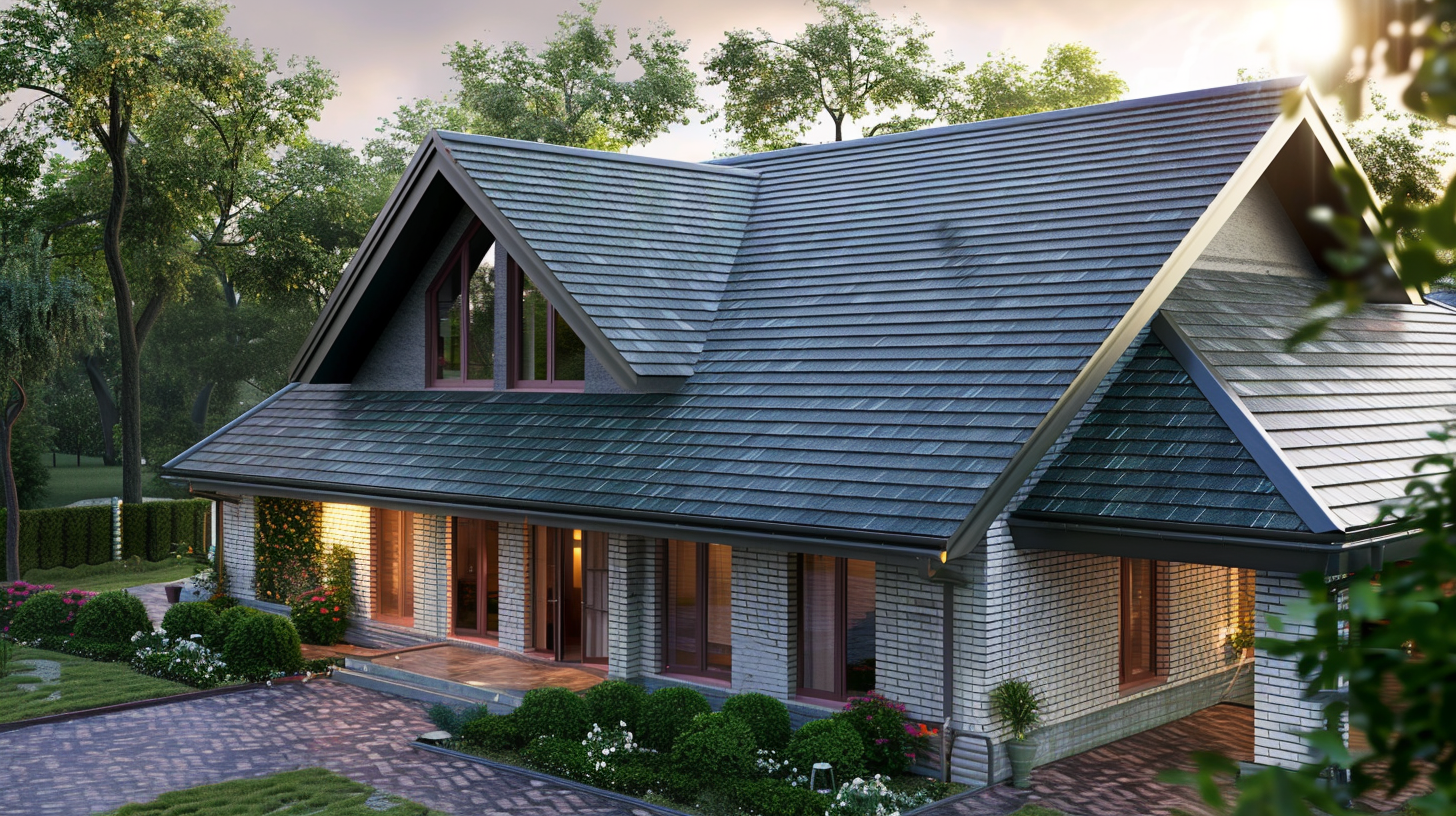
Rubber Roofs - Benefits of Rubber Roofs - Sky Roofing Construction & Remodeling
Benefits of Rubber Roofs
Rubber shingles, made from synthetic rubber membranes such as ethylene propylene diene monomer (EPDM), are known for their flexible rubber material, contributing to their durability and ease of installation. The application methods for rubber roofs are straightforward, further adding to their appeal. Despite the initial labor cost, long-term maintenance and energy efficiency savings make rubber roofs cost-effective.
Durability
Furthermore, rubber roofs are low-maintenance and eco-friendly, making them cost-effective for long-term roofing needs. The material requires minimal upkeep, saving homeowners time and money in the long run. Additionally, rubber roofing is eco-friendly as it is often made from recycled materials and is fully recyclable at the end of its lifespan.
For roof installation, rubber roofing materials are lightweight, which eases the process and minimizes strain on the structural integrity of the building. Rubber roofing can be an excellent repair material when undertaking a complete tear-off of an old roof, providing a new, durable layer without adding significant weight. Using rubber roofing for flat and low-sloped roofs enhances the overall efficiency and longevity of the roofing system, making it a wise investment for property owners.
Energy Efficiency
Proper installation is crucial for low-sloped or flat roofs to maximize the benefits of EPDM and other single-ply roofing systems. Single-ply roofing systems like EPDM, TPO, and PVC are popular options. However, their suitability for different climates varies. EPDM is a versatile choice that performs well in various climates. TPO is known for its heat resistance, making it ideal for warm regions. PVC, on the other hand, is highly resistant to chemicals and extreme temperatures, making it suitable for harsh environments.
When considering cost-effectiveness, EPDM has an advantage over other commercial roofing systems. It is relatively affordable compared to alternatives like PVC and offers good durability, requiring less maintenance and potential repairs in the long run. Attention to factors such as proper installation and membrane color can further enhance the performance and longevity of EPDM roofing systems, making them an intelligent choice for various roofing projects.
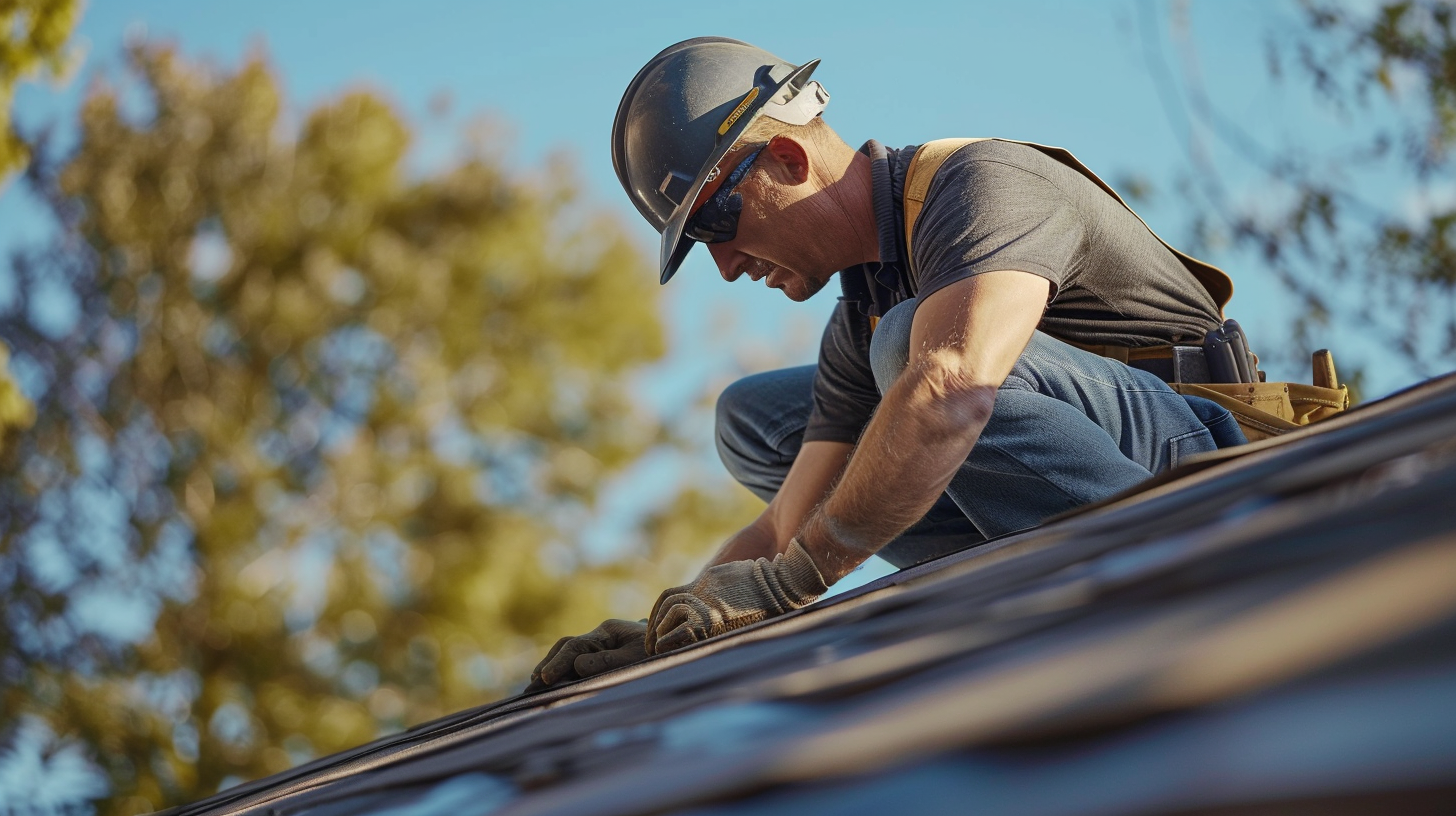
Rubber Roofs - Low Maintenance - Sky Roofing Construction & Remodeling
Low Maintenance
With EPDM roofing, the top maintenance practices include regular inspections, prompt damage repair, regular cleaning, and patching as needed. By following these practices, homeowners can ensure the longevity and durability of their rubber roofs, extending the roof life beyond the average roof lifespan. Choosing quality roof materials and hiring an experienced rubber roofing contractor can further enhance the performance and durability of the roof.
Cost-Effective
Rubber roof installation is straightforward, making it an appealing application for rubber roofing in new builds and roof replacement projects. While the initial installation might have an additional cost, the long-term savings in maintenance costs make it a cost-effective choice. Regular maintenance is essential to maximize roof performance and longevity, ensuring low maintenance costs.
The average cost of rubber roofing varies, but its affordability, low maintenance requirements, and ease of repair make it a competitive option. Property owners can achieve a durable, long-lasting roofing solution that minimizes additional costs associated with frequent repairs or premature replacements by selecting quality commercial roofing materials and ensuring proper installation.
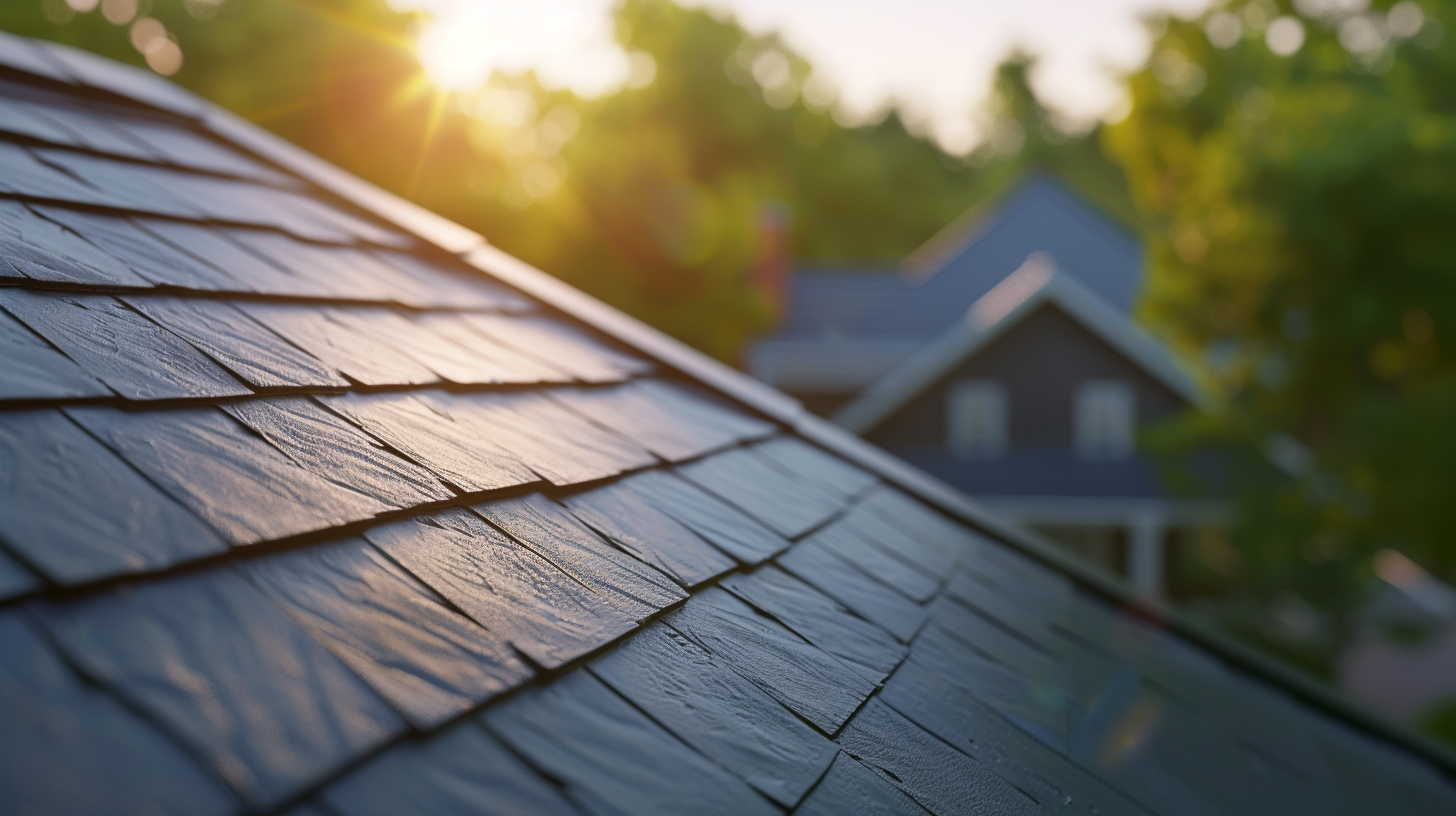
Rubber Roofs - Types of Rubber Roofs - Sky Roofing Construction & Remodeling
Types of Rubber Roofs
Rubber roofing is a cost-effective and resilient choice when considering roof options. Popular alternatives to rubber roofing include modified bitumen and built-up roofs, but EPDM’s ease of maintenance and longevity make it an attractive option for roofs of various types. To install rubber roofing, professionals often consider the specific requirements of the building and choose the most suitable type of rubber roofing system. This ensures the installation is effective and long-lasting, providing reliable protection against weather and environmental damage.
EPDM Rubber Roofs
EPDM rubber roofs are also highly resistant to water damage, which minimizes the risk of leaks over time. Regular maintenance is essential for preserving their durability and functionality. EPDM roofs require minimal upkeep, typically regular inspections, cleaning, and promptly addressing potential leaks or damage.
TPO Rubber Roofs
Moreover, TPO roofs contribute to a property’s curb appeal, with their sleek and modern appearance enhancing the overall aesthetic appeal. Proper roof maintenance is essential to preserve this appeal and extend the lifespan of TPO roofs. Regular inspections and maintenance procedures help promptly identify and address any issues, ensuring the roofing system’s integrity. Additionally, attention to details such as roof penetrations, such as vents and chimneys, is crucial to prevent potential leaks and maintain the effectiveness of the TPO roofing system.
PVC Rubber Roofs
Furthermore, PVC rubber roofing is a roof membrane type known for its energy efficiency and durability. Its reflective properties help to reduce cooling costs and improve overall energy conservation. These roofs are also well-suited for accommodating rooftop equipment, providing a durable and stable surface for installations such as HVAC systems and solar panels.
Discover the Benefits of Rubber Roofs with Sky Roofing Construction & Remodeling
Rubber roofs offer a durable, energy-efficient, and low-maintenance solution for residential and commercial buildings. Whether you’re interested in EPDM, TPO, or PVC rubber roofs, understanding their unique benefits can help you decide on your property. Contact Sky Roofing Construction & Remodeling (https://skyroofingconstructiontx.com) today to schedule a free roofing quotation and discover how rubber roofs can enhance your building’s longevity and efficiency. Call (210) 942-9797 to get started!
The post Benefits of Rubber Roofs: Durability, Energy Efficiency, and Sustainability appeared first on Roofing Contractor San Antonio - Sky Roofing Construction & Remodeling.
from Roofing Contractor San Antonio – Sky Roofing Construction & Remodeling https://skyroofingconstructiontx.com/rubber-roofs/
via Sky Roofing Construction & Remodeling
Posted on June 21st, 2024
Benefits of Rubber Roofs: Durability, Energy Efficiency, and Sustainability

Rubber Roofs
Overview of Rubber Roofing Membranes
In commercial roof systems, choosing a suitable flat roofing material is crucial. A flat roofing project must consider cost, durability, and maintenance. Due to their specific benefits, EPDM, TPO, and PVC are popular choices for commercial roof systems. While EPDM is a shared roof material for its cost-effectiveness and ease of installation, TPO offers additional energy efficiency, making it suitable for environmentally conscious projects. PVC, though the most expensive, provides the most extended lifespan and the highest resistance to environmental factors, making it ideal for long-term flat roofing projects.

Rubber Roofs - Benefits of Rubber Roofs - Sky Roofing Construction & Remodeling
Benefits of Rubber Roofs
Rubber shingles, made from synthetic rubber membranes such as ethylene propylene diene monomer (EPDM), are known for their flexible rubber material, contributing to their durability and ease of installation. The application methods for rubber roofs are straightforward, further adding to their appeal. Despite the initial labor cost, long-term maintenance and energy efficiency savings make rubber roofs cost-effective.
Durability
Furthermore, rubber roofs are low-maintenance and eco-friendly, making them cost-effective for long-term roofing needs. The material requires minimal upkeep, saving homeowners time and money in the long run. Additionally, rubber roofing is eco-friendly as it is often made from recycled materials and is fully recyclable at the end of its lifespan.
For roof installation, rubber roofing materials are lightweight, which eases the process and minimizes strain on the structural integrity of the building. Rubber roofing can be an excellent repair material when undertaking a complete tear-off of an old roof, providing a new, durable layer without adding significant weight. Using rubber roofing for flat and low-sloped roofs enhances the overall efficiency and longevity of the roofing system, making it a wise investment for property owners.
Energy Efficiency
Proper installation is crucial for low-sloped or flat roofs to maximize the benefits of EPDM and other single-ply roofing systems. Single-ply roofing systems like EPDM, TPO, and PVC are popular options. However, their suitability for different climates varies. EPDM is a versatile choice that performs well in various climates. TPO is known for its heat resistance, making it ideal for warm regions. PVC, on the other hand, is highly resistant to chemicals and extreme temperatures, making it suitable for harsh environments.
When considering cost-effectiveness, EPDM has an advantage over other commercial roofing systems. It is relatively affordable compared to alternatives like PVC and offers good durability, requiring less maintenance and potential repairs in the long run. Attention to factors such as proper installation and membrane color can further enhance the performance and longevity of EPDM roofing systems, making them an intelligent choice for various roofing projects.

Rubber Roofs - Low Maintenance - Sky Roofing Construction & Remodeling
Low Maintenance
With EPDM roofing, the top maintenance practices include regular inspections, prompt damage repair, regular cleaning, and patching as needed. By following these practices, homeowners can ensure the longevity and durability of their rubber roofs, extending the roof life beyond the average roof lifespan. Choosing quality roof materials and hiring an experienced rubber roofing contractor can further enhance the performance and durability of the roof.
Cost-Effective
Rubber roof installation is straightforward, making it an appealing application for rubber roofing in new builds and roof replacement projects. While the initial installation might have an additional cost, the long-term savings in maintenance costs make it a cost-effective choice. Regular maintenance is essential to maximize roof performance and longevity, ensuring low maintenance costs.
The average cost of rubber roofing varies, but its affordability, low maintenance requirements, and ease of repair make it a competitive option. Property owners can achieve a durable, long-lasting roofing solution that minimizes additional costs associated with frequent repairs or premature replacements by selecting quality commercial roofing materials and ensuring proper installation.

Rubber Roofs - Types of Rubber Roofs - Sky Roofing Construction & Remodeling
Types of Rubber Roofs
Rubber roofing is a cost-effective and resilient choice when considering roof options. Popular alternatives to rubber roofing include modified bitumen and built-up roofs, but EPDM’s ease of maintenance and longevity make it an attractive option for roofs of various types. To install rubber roofing, professionals often consider the specific requirements of the building and choose the most suitable type of rubber roofing system. This ensures the installation is effective and long-lasting, providing reliable protection against weather and environmental damage.
EPDM Rubber Roofs
EPDM rubber roofs are also highly resistant to water damage, which minimizes the risk of leaks over time. Regular maintenance is essential for preserving their durability and functionality. EPDM roofs require minimal upkeep, typically regular inspections, cleaning, and promptly addressing potential leaks or damage.
TPO Rubber Roofs
Moreover, TPO roofs contribute to a property’s curb appeal, with their sleek and modern appearance enhancing the overall aesthetic appeal. Proper roof maintenance is essential to preserve this appeal and extend the lifespan of TPO roofs. Regular inspections and maintenance procedures help promptly identify and address any issues, ensuring the roofing system’s integrity. Additionally, attention to details such as roof penetrations, such as vents and chimneys, is crucial to prevent potential leaks and maintain the effectiveness of the TPO roofing system.
PVC Rubber Roofs
Furthermore, PVC rubber roofing is a roof membrane type known for its energy efficiency and durability. Its reflective properties help to reduce cooling costs and improve overall energy conservation. These roofs are also well-suited for accommodating rooftop equipment, providing a durable and stable surface for installations such as HVAC systems and solar panels.
Discover the Benefits of Rubber Roofs with Sky Roofing Construction & Remodeling
Rubber roofs offer a durable, energy-efficient, and low-maintenance solution for residential and commercial buildings. Whether you’re interested in EPDM, TPO, or PVC rubber roofs, understanding their unique benefits can help you decide on your property. Contact Sky Roofing Construction & Remodeling (https://skyroofingconstructiontx.com) today to schedule a free roofing quotation and discover how rubber roofs can enhance your building’s longevity and efficiency. Call (210) 942-9797 to get started!
The post Benefits of Rubber Roofs: Durability, Energy Efficiency, and Sustainability appeared first on Roofing Contractor San Antonio - Sky Roofing Construction & Remodeling.
from Roofing Contractor San Antonio – Sky Roofing Construction & Remodeling https://skyroofingconstructiontx.com/rubber-roofs/
via Sky Roofing Construction & Remodeling
Posted on June 21st, 2024
Rubber Roofs - Sky Roofing Construction & Remodeling - Call (210) 942-9797
Watch video on YouTube here: https://www.youtube.com/watch?v=ndyhP1F4hic
via Sky Roofing Construction & Remodeling
Posted on June 21st, 2024
Rubber Roofs - Sky Roofing Construction & Remodeling - Call (210) 942-9797
Watch video on YouTube here: https://www.youtube.com/watch?v=ndyhP1F4hic
via Sky Roofing Construction & Remodeling
Posted on June 21st, 2024
Green Roofs - Sky Roofing Construction & Remodeling - Call (210) 942-9797
Watch video on YouTube here: https://www.youtube.com/watch?v=H_zCD5l3xSg
via Sky Roofing Construction & Remodeling
Posted on June 20th, 2024
The Power of Green Roofs: How They Benefit Cities and the Environment

Green Roofs
These eco-friendly solutions combat various urban challenges, such as the urban heat island effect, stormwater runoff, and air pollution. Additionally, green roofs can enhance the aesthetic appeal of buildings, provide insulation to reduce energy consumption, improve air quality, and offer a sanctuary for wildlife in densely populated areas. With numerous advantages, green roofs have emerged as a sustainable and progressive roofing option for residential and commercial buildings.
Importance of Green Roofs in Urban Environments
Benefits of Green Roofs
Furthermore, green roofs improve air quality by filtering pollutants and CO2 from the atmosphere, promoting a healthier environment. The vegetative layer on the rooftop greenery helps reduce ambient air temperatures, which can be particularly beneficial in urban areas where heat islands are a concern. Additionally, the ecological benefits of green roofs include emissions reduction and the promotion of biodiversity by providing habitats for various species.
Green roofs also offer psychological benefits by creating a green environment that enhances the connection with nature for building occupants. This connection can reduce stress and improve overall well-being. Lastly, these roofs have the potential to offer additional usable green space, creating opportunities for gardening, recreation, and relaxation in urban areas. An accessible roof with rooftop greenery can transform a previously unused space into a valuable community asset, promoting physical and mental health.
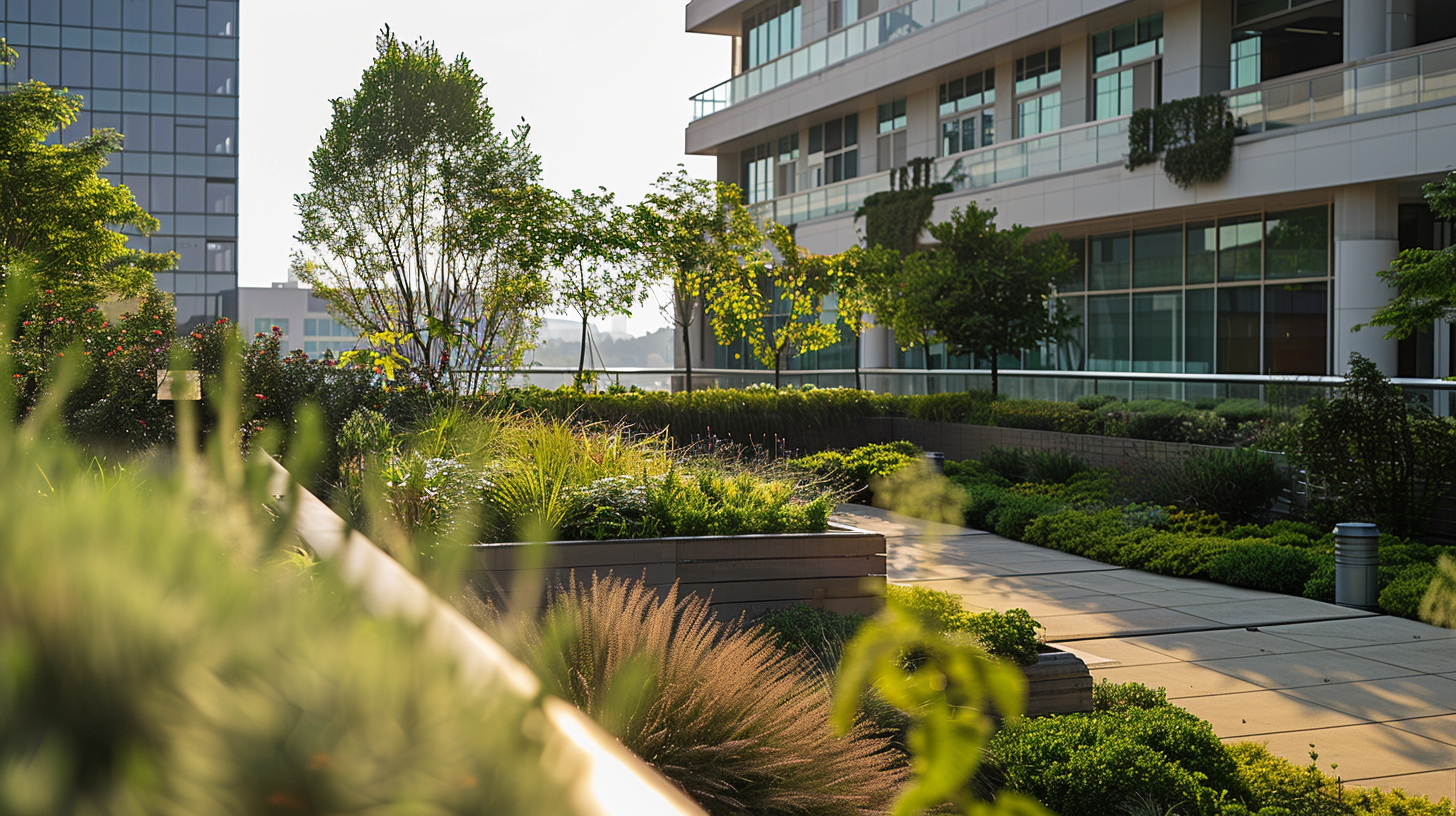
Green Roofs - Types of Green Roofs - Sky Roofing Construction & Remodeling
Types of Green Roofs
Additionally, there are modular green roofs, which consist of pre-grown plant modules that are easy to install and maintain. These roofs are often used in urban areas and can provide insulation, stormwater management benefits, and energy cost savings. Modular green roofs can be an excellent option for residential and office buildings looking to reduce their energy consumption and improve their green environment.
Lastly, there are biodiverse roofs, which focus on supporting a diverse range of plant and animal species. These roofs help promote biodiversity and provide insect, bird, and other wildlife habitats. Biodiverse roofs often include additional layers to support the complex ecosystem they foster. Unlike traditional roofs, green roofs offer significant ecological benefits and can be designed to meet specific needs and preferences, whether for a small residential building or a large commercial complex. By converting a conventional roof into a green roof, property owners can enjoy various environmental, economic, and social benefits, transforming underutilized space into valuable, sustainable assets.
Intensive Green Roofs
Intensive green roofs also create aesthetically pleasing green spaces in urban areas, improving air quality and providing habitats for wildlife. Additionally, they can enhance the overall well-being and quality of life for occupants of the building. With their diverse vegetation and extensive design, intensive green roofs offer numerous benefits and advantages for the environment and buildings.
Extensive Green Roofs
Semi-intensive Green Roofs
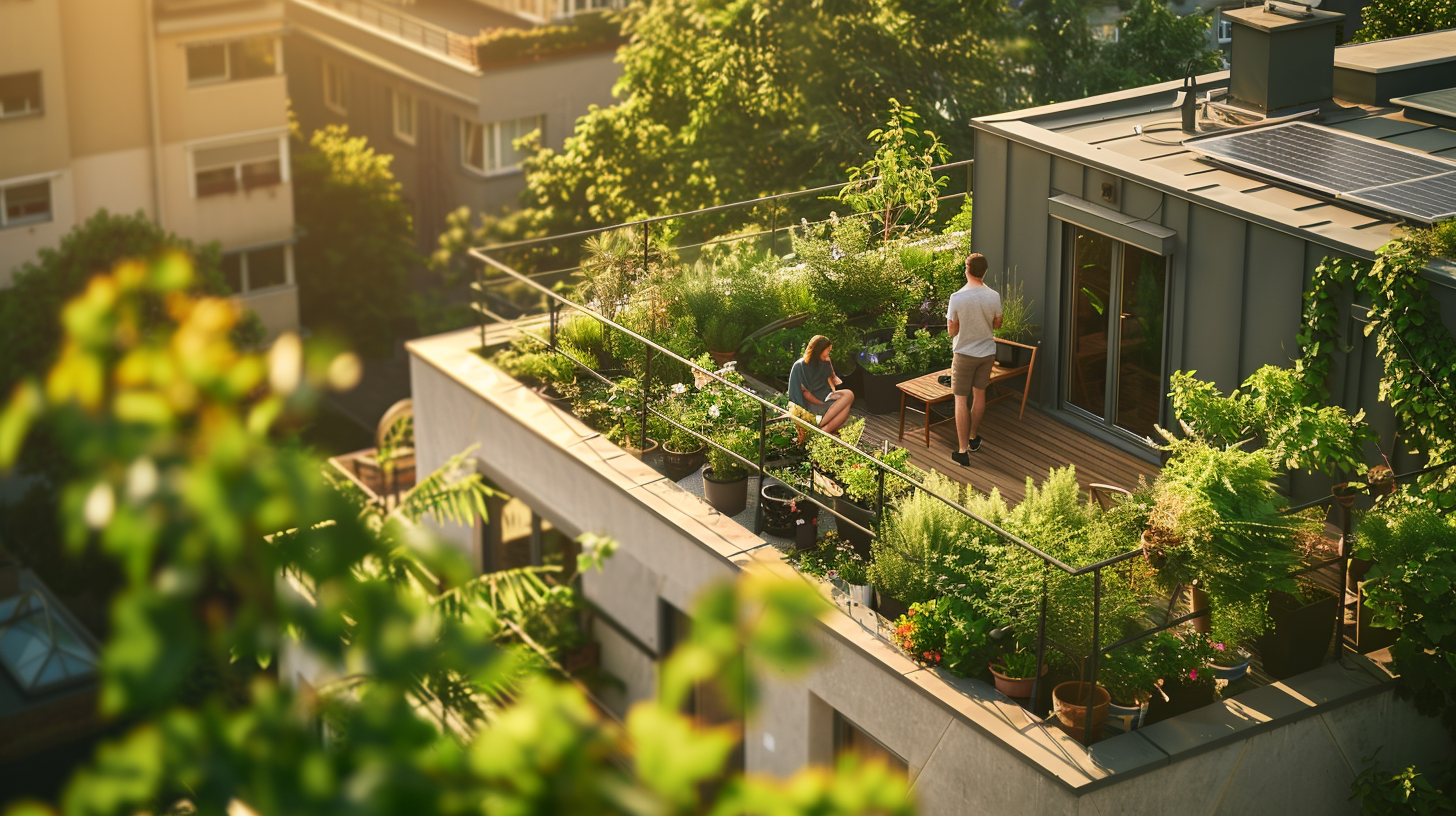
Green Roofs - Components of a Green Roof - Sky Roofing Construction & Remodeling
Components of a Green Roof
The roof membrane is the waterproofing membrane that protects the building from water infiltration, ensuring the structure remains intact. The vegetation layer, comprised of green roof plants such as sedums, grasses, and herbs, provides insulation, reduces the urban heat island effect, and improves air quality. The filter fabric prevents the drainage layer from clogging with dirt and debris, allowing water to flow freely.
The drainage layer, typically lightweight, helps manage excess water runoff. The growing medium, which varies in depth of planting medium depending on the green roof type, provides nutrients and support for the vegetation.
Green roofs can be divided into extensive roofs and intensive roofs. Extensive roofs are shallow and lightweight, requiring minimal maintenance. In contrast, intensive roofs are thicker and can support a broader range of plant species, offering more excellent aesthetic value and recreational space. Both green roofs provide significant energy cost savings by improving the building’s insulation, reducing the need for heating and cooling.
Additionally, green roofs can integrate solar panels, maximizing commercial roof space for energy production and reducing energy costs. Unlike traditional rooftops made from conventional materials, green roofs offer a sustainable alternative that benefits both the environment and the building occupants.
By transforming a traditional rooftop into a green roof, property owners can enjoy the ecological benefits of a green roof while contributing to a greener urban landscape. Green roofs represent a forward-thinking approach to sustainable building practices, whether installed on a residential or commercial roof space.
Waterproof Membrane
These membranes can include options like ethylene propylene diene monomer (EPDM), thermoplastic olefin (TPO), and reinforced bitumen membranes. Each type has specific features, such as flexibility, resistance to UV radiation, and ease of installation, providing customers with various choices when considering green roofs.
Drainage Layer
Filter Cloth
Growing Medium
Coco coir, derived from coconut husks, offers excellent water retention properties while remaining lightweight. Peat moss, composed of decomposed plant materials, is known for its moisture retention abilities. Perlite, a volcanic rock, aids in water retention and improves drainage, while vermiculite, a naturally occurring mineral, enhances water-holding capacity. These different types of growing mediums enable green roofs to support a variety of plant species, contributing to their multiple benefits and advantages.
Vegetation
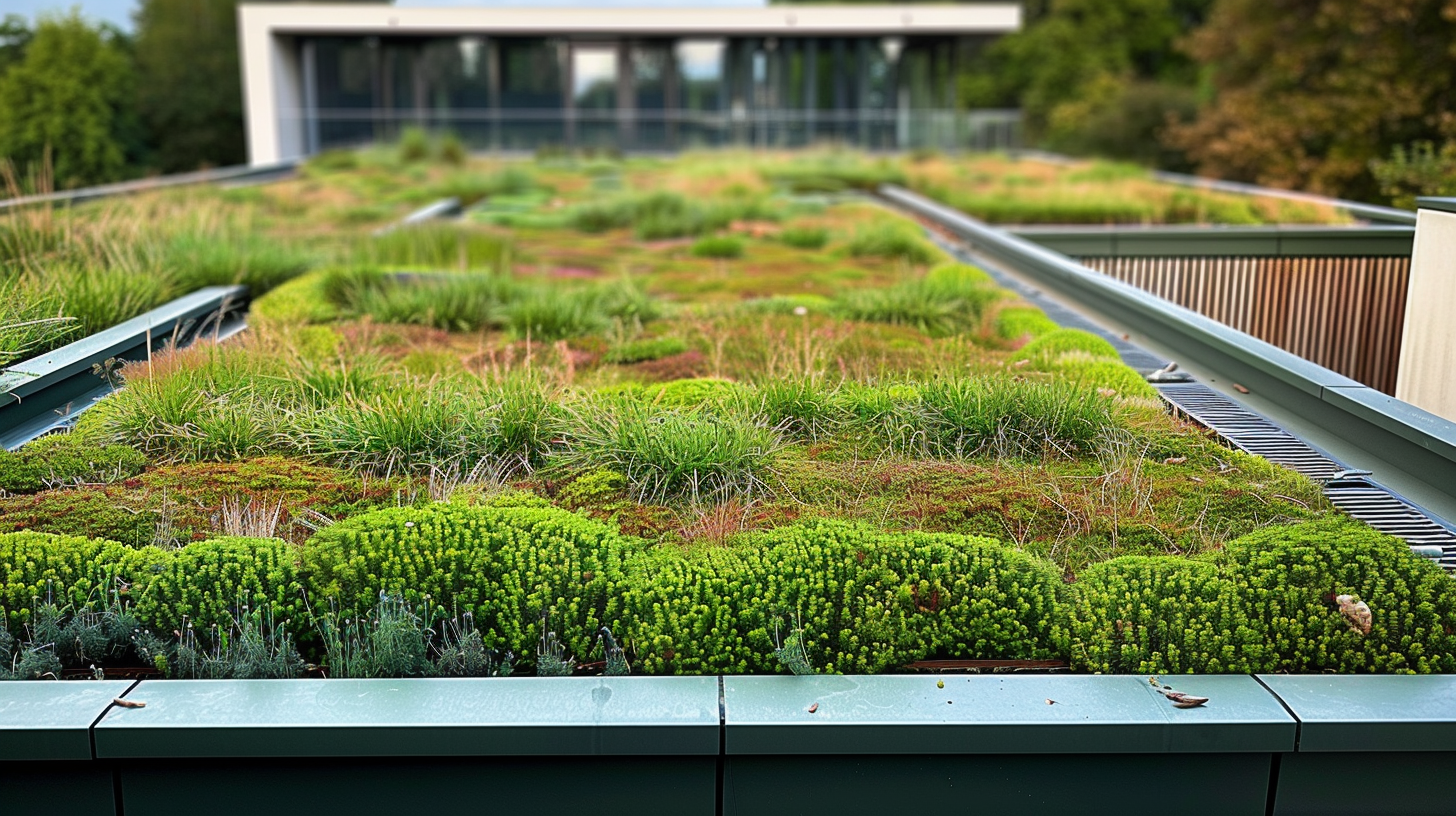
Green Roofs - Green Roof Technologies - Sky Roofing Construction & Remodeling
Green Roof Technologies
Numerous advantages exist to green roofs, including how these innovative roofing solutions can enhance thermal insulation, reduce stormwater runoff, mitigate urban heat island effects, and support biodiversity. A well-planned green roof project considers design elements such as the root barrier to protect the underlying roof structure and effective rainwater management to prevent excess water buildup.
The cost of green roofs can vary based on the design’s complexity and the vegetation types used. Despite the initial investment, green roofs can lead to significant long-term savings by reducing energy usage for heating and cooling. Integrating these roofs helps capture and utilize rainwater, thus alleviating the burden on urban drainage systems.
Types of Green Roof Systems
Extensive green roofs are lightweight and low-maintenance. They typically feature a thin layer of vegetation and limited plant diversity. They require minimal irrigation and upkeep, making them ideal for large-scale projects. This green roof installation type is famous for its ease and efficiency.
Semi-intensive green roofs have a greater diversity of plants and a more profound growing medium, resulting in a broader range of vegetation. They require moderate maintenance, including regular irrigation and occasional fertilization. On the other hand, intensive green roofs have a deeper soil profile and support a diverse selection of plants, including trees and shrubs. Due to their complexity, intensive green roofs require regular irrigation, fertilization, and ongoing maintenance.
Monolithic green roofs are pre-assembled and typically consist of a single layer of vegetation. They are relatively simple to install and require minimal maintenance. This type of green roof installation is beneficial for quick and straightforward setups.
Lastly, modular green roofs consist of self-contained units that are easily installed and can be removed or replaced as needed. They require regular maintenance, including irrigation and fertilization.
The implementation of green roofs also provides significant social benefits. By reducing ambient temperatures and promoting a cooler urban environment, green roofs help mitigate the urban heat island effect. They can also enhance the overall aesthetic of a building and its surroundings, promoting a sense of well-being among residents and visitors.
Cool roofs, another sustainable roofing option, work well with green roofs to reduce energy consumption and improve building efficiency. Ongoing green roof research continues to uncover additional benefits and best practices for maximizing the effectiveness of these systems.
Choose Green Roofs with Sky Roofing Construction & Remodeling
Green roofs offer diverse benefits for urban environments, including managing stormwater, reducing heat island effects, and improving air quality. Choose Sky Roofing for a sustainable future (https://skyroofingconstructiontx.com); we specialize in transforming rooftops into sustainable green spaces that enhance energy efficiency and support biodiversity. Contact us at (210) 942-9797 to start your journey towards a greener building with our expert installation and maintenance services.
The post The Power of Green Roofs: How They Benefit Cities and the Environment appeared first on Roofing Contractor San Antonio - Sky Roofing Construction & Remodeling.
from Roofing Contractor San Antonio – Sky Roofing Construction & Remodeling https://skyroofingconstructiontx.com/green-roofs/
via Sky Roofing Construction & Remodeling
Posted on June 20th, 2024

